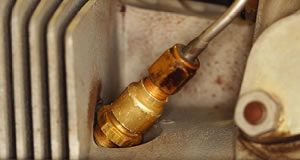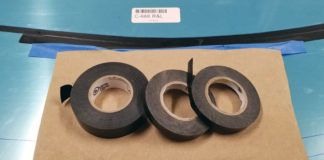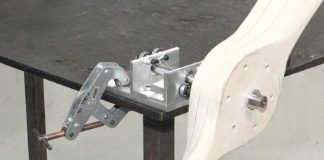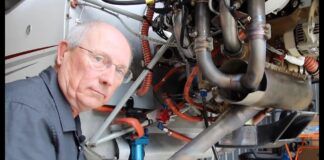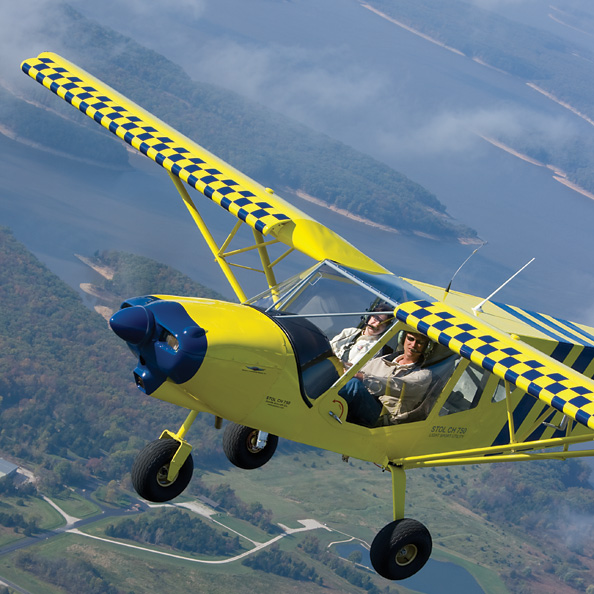
 Some of the most successful aircraft designs are those penned by individuals with strong beliefs. In fact, it’s basically a self-selecting trait: Creating a unique aircraft, particularly with the intention of selling into the owner-constructed field, isn’t for the faint of heart, weak of will or non-self-possessed. When well harnessed, those beliefs can lead to singlemindedly good aircraft that carry an imprint so strong that even a lengthy evolution and ongoing development by other pilots and engineers cannot overwrite the base DNA.
Some of the most successful aircraft designs are those penned by individuals with strong beliefs. In fact, it’s basically a self-selecting trait: Creating a unique aircraft, particularly with the intention of selling into the owner-constructed field, isn’t for the faint of heart, weak of will or non-self-possessed. When well harnessed, those beliefs can lead to singlemindedly good aircraft that carry an imprint so strong that even a lengthy evolution and ongoing development by other pilots and engineers cannot overwrite the base DNA.
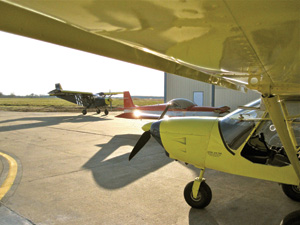
Three of the four airplanes tested in a day, the CH 750 (foreground), the CH 601 XL/B (over the nose) and the CH 801 (background).
So it is with the Zenith homebuilts. Chris Heintz penned his first design in the late 1960s, with the initial example flying before the decade was out. From the beginnings of Zenith as a kit manufacturer in 1974 to now, the number of airplanes that are either his alone or that include his efforts in consultation number more than a dozen; currently, four designs are offered as kits from the Mexico, Missouri-based Zenith Aircraft Company, run by one of Chris’s sons, Sebastien Heintz.
All Zenith designs share conceptual design points and an emphasis on a certain part of the performance envelope—namely, short takeoff and landing (STOL). And while this short-field bent varies in intensity by model—it’s more prevalent in the high-wing designs than the low-wingers—all carry the stamp of a designer who values low stall speeds and sprightly runway performance over raw speed. Moreover, the design ethic here leans massively toward simplicity and ease of construction.
Each of the current designs is predominantly metal, with a minimum of fiberglass, and is created largely from 6061, a forgiving, relatively inexpensive aluminum alloy. With a few notable exceptions, the structure is stitched together with Avex blind rivets—really, they’re too nice and far too expensive to be called “pop” rivets—that greatly ease construction and, for that matter, change the way the airplanes are intended to be built. For more on this, see “Around the Patch: Starting at the Back.”
Sampler Platter
While I was tossing Clecoes around and popping rivets at the Zenith factory in the process of building a rudder at a recent two-day workshop, four demonstrator aircraft were made available. It’s unusual for a visiting journalist to have the chance to fly a veritable story arc of a company’s designs, in part because so few kit makers keep a raft of demo airplanes around. Heintz was eager for me to try the four aircraft stationed at the factory: A STOL CH 701, a CH 750, a CH 601 XL/B and a CH 801 four-seater.

In case you missed the family reunion, here’s a primer to help you recognize the quartet. The CH 701 is a high-wing utility aircraft first sold in 1986 and intended to be useful with as few as 50 horsepower. The CH 601 is the company’s low-wing offering that is now well developed in the form of the CH 650. (The firm was in the process of building a CH 650 demonstrator during my visit; those long Missouri winters will help keep the factory boys focused.) The CH 801 is a 701 with a glandular problem—its four seats follow a Lycoming O-360 through the air and hang beneath a thick-airfoil wing with fixed leading-edge slats and full-span flaperons—ailerons and flaps that are set below and behind the trailing edge of the main wing. (The gap here is less than you see in a Kitfox, though.) Finally, the CH 750, as the newest member of the clan, represents the family’s latest thinking in a two-seat, high-wing utility aircraft.
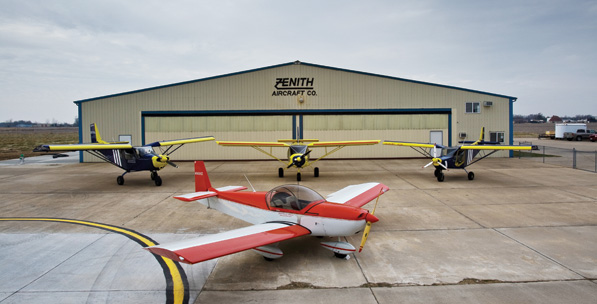
Company pilot Roger Dubbert and I clambered into the CH 701. I remember meeting designer Chris Heintz 20 years ago and recall him as a typically lean Swiss, ready to go hiking at the drop of a Tyrolean hat. This would explain the interior of the 701. At 5-foot-9, I’m not big, but the cabin felt a bit tight, and my knees were bent sufficiently that it was possible to rest a forearm on thigh and make full contact with the unusual Y-shaped center stick. A call for full aileron would require some cooperation in the cabin and a bit of hokey-pokey legwork.
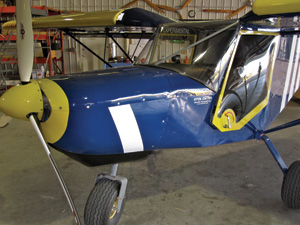
The CH 701 capsule review: Great STOL performance, tight cabin.
What the 701 lacks in cabin size it compensates for in low weight, with the aircraft typically less than 600 pounds empty. Against a maximum-gross weight of 1100 pounds, you get a good payload figure. And while a 50-horse Rotax would no doubt make the 701 an acceptable performer, the factory ship was fitted with a Rotax 912S; the 100-hp mill is the largest specified for the 701. Now the power loading is pretty sporting and the airplane’s 122 square feet of thick aluminum wing can, pardon the pun, strut its stuff.
Dubbert and I turned the 701 onto Runway 18 at Mexico Memorial into a 15-knot wind headed nearly down the stripe. Low weight, big wing, fine-pitched (ground adjustable) prop, do your thing: Count to three, quickly, and the 701 is airborne, clawing for pattern altitude at a ridiculous deck angle. In fact, this is the most disconcerting part of the flight. For this impression, thank all of those high-lift devices. Indeed, not only is the main wing almost comically thick, but the horizontal tail is a true airfoil shape, and there is a row of vortex generators nestled in the gap between the stabilizer and elevator; they are exposed when the elevator is nearly full trailing-edge up to help keep flow attached. The 701 is determinedly maneuverable with the airspeed indicator barely tickling off the lower peg—and, yes, we know that at those crazy angles of attack the instrument can hardly be counted on to be accurate. Even so, it’s an impressive sight from the cockpit.
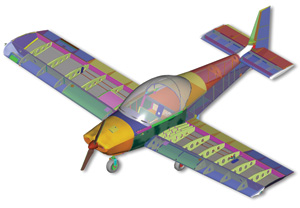
Simple structure and no-nonsense systems give the Zenith designs a reputation as being easy to build.
Lowering the nose restores some forward view and we make our way, slowly into the wind, southward for maneuvering. With 70 mph showing, the 701’s controls firm up nicely, with good balance between roll and pitch, and positive pitch stability. Roll stability is neutral. Put in the bank angle, coordinate with rudder, and it holds the turn until another bump comes along to alter your course.
Rudder? Well, that’s another surface entirely. In all Zenith designs, the rudder is all-flying, with no fixed vertical stabilizer, just a small dorsal fin leading up to the rudder itself. The vast majority of the surface is behind the hinge line. In addition, the CH series uses direct nosewheel steering through the rudder pedals that imparts its own forces into the system. The nosewheel is cushioned from vertical impacts by riding in a U-shaped slot on the firewall, the forces absorbed by a simple bungee cord wrapped around a set of pegs. This cord not only supports the nosewheel strut vertically but also partly resists the strut twisting, which helps keep the nosewheel centered and inflicts some friction into the whole yaw-control apparatus.
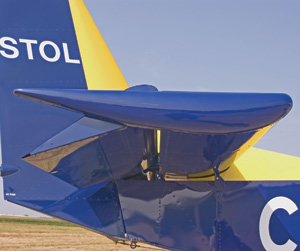
All high-wing Zenith designs have dramatically cambered horizontal stabilizers for improved pitch authority at vanishingly low airspeeds.
As a result of this system, the CH 701 requires you to carefully coordinate rudder with aileron, leading aggressively and being sensitive about when to relax and let the airplane turn. Not only that, the rudder is powerful, so just a mild push here and a gentle shove there will keep the ball in the center. Or until you learn the ropes, the ball clinking off the end of the rack. (I haven’t broken one yet, but I seem to keep trying.)
Cruise flight and maneuvering trails showed no unusual traits. The stall, when it comes, is far more of a straight-ahead mush, with the stick far, far back—you might look like you’re reaching into the baggage compartment for a soda, it’s that far back. Maintaining bank angle with the ailerons is a bit of a challenge with the stick about even with your ribcage, but you should be active on the rudders at that speed anyway.
Back to the airport, Dubbert demonstrated a landing before handing the airplane back to me for a couple of bounce-and-goes. In all ways but one, the CH 701 is a snap to land. The difficulty? Getting it out of your head that there’s even the slightest chance of float if you’ve heeded the recommended 55-mph approach speed. All that drag joins hands with all that lift in a normal-speed flare to kill energy quickly. Arrive over the numbers on speed, hike that nose waaay up and the airplane just stops. And I mean stops. Into a modest wind, it’s like you caught the center wire without all that afterburner and neck-stretching the Navy guys brag about. Stick back, plop, and there you are, hardly moving.
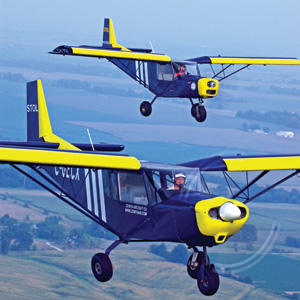
The CH 801 is in the foreground, with the 701 trailing behind. In fact, the size difference between the two is greater than this photo would have you believe.
Bring in the Next Victim
After the CH 701 flight came its much larger brother, the CH 801. Mass changes a lot, so it’s not surprising to see the 801 act like the 701 only in relative slow motion with regard to its reflexes. It takes longer to accelerate, requires more strength to drag the Y-stick back, and it rolls on the puffy maingear tires a bit longer. While still pleasantly light in roll, the 801’s responses are, if not comparatively molasses-like, perhaps just thinly frosted.
We flew the 801 very light on fuel and with the back seats empty. That probably explains my inability to promptly rotate the nose to the requisite high angle for takeoff, and the airplane’s tendency to plop the nosewheel onto the runway soon after the mains touched.
Even though the 801 is clearly heftier than its two-seat brother, it still has the feel of a light aircraft. Wing loading might explain it: With 167 square feet of wing holding just 2200 pounds of airplane—and for us, less, as I estimate our dispatch weight at under 1600 pounds—the 801 balloons and rocks through turbulence; still, it keeps going where you point it, and like the 701, is resolutely pitch stable.
Put the Wing Down Below
Climbing out of the 801 and hopping into the CH 601 XL/B is a bit like leaving the rental-car shuttle bus to find a sleek sports car with your name on it. Because Zenith tends to keep its demonstrators around, this particular 601 XL has many of the older features. They include ailerons that use their upper skins as hinges—there are no conventional rotating hinges here—as well as a smaller canopy and a previously specified angle of incidence on the main wing.
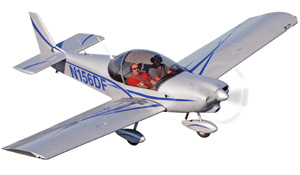
The CH 650 is the most advanced version of Zenith’s low-wing clan; it features a taller canopy and revised aerodynamics.
Zenith’s latest version, the CH 650, has a much larger canopy; I felt slightly cramped under the 601’s bubble. The 650 also has increased main wing incidence over the 601. This will cure the one big complaint I had of the 601: When trundling down final at the recommended 65 mph with full flaps, you really can’t see much of the runway. Pilots will compensate by flying faster (as I did on the first approach) to put the runway in view, and then struggle to dissipate the speed over the numbers. Or they will resort to arc-like finals so the pavement remains in their sights. Eventually, I became accustomed to the lack of view over the nose, and committed landings that wouldn’t embarrass my primary flight instructor.
Speed is the payback. Zenith says the CH 650 using a Rotax 912S will go 160 mph true airspeed, which is a long way from the 701’s 85 mph on the same engine. I can’t verify that number, as Dubbert and I spent the entire flight maneuvering and trying to get the 601 to actually stall—like the other CH model’s I’d flown that day, it gave a lot of aerodynamic warning in the full-flaps stall and seemed contented to mush straight ahead, losing 800 to 1000 feet.
Now the 750
My final flights of the day were solo in the CH 750 after Dubbert had apparently decided I wasn’t going to bend any metal—at least not so badly that it couldn’t be fixed. As the latest design, the 750 should be the best developed, most mature of the bunch, and it is. It’s hard to describe exactly because the sensation is almost subliminal, but all of the first impressions of things in the 701 I thought might annoy me after time were simply absent in the 750. Perhaps it was the little items I’d begun to notice, such as the streamline strut tubing—nicer looking than the 701’s round-tube struts with their obvious splice, or the nicely adjustable seats, or even the improved panel layout with modern instruments. Hard, exactly, to know what influenced my mindset most—could just have been the 750’s “new airplane” smell.
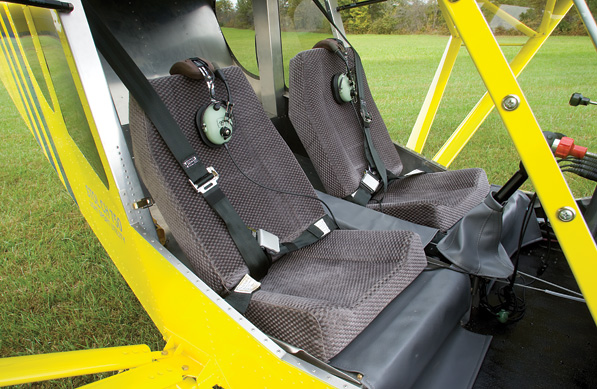
The CH 750 has a much larger cabin than the 701, while maintaining nearly the same performance on similar power.
The CH 750’s cabin is much, much roomier, a fact embellished upon by the great visibility. Bubble doors afford a peek straight down, while the cutaway at the corners of the instrument panel give you a sliver of the lower outboard corners of the windshield to see through. I didn’t think much of that feature until the first solo takeoff.
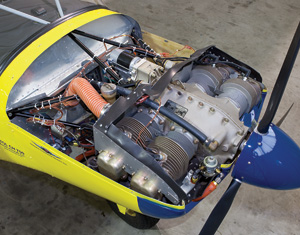
Although the CH 750 flown for this report was fitted with a Jabiru 3300, one option for the design is the Continental O-200.
The process with the Jabiru 3300 (120 hp versus the Rotax’s 100, spinning a two-blade WhirlWind composite prop) is to throttle up with the brakes on, release, begin to think about counting to two, and then hike the nose up. Pop…the 750 is off the ground and climbing at an obscene angle, with full control authority and the sensation of ample lift in those thick wings.
Without Dubbert in the airplane, the 750 wanted to roll in the pilot’s direction—adjustable roll trim would be a nice addition—and the initial climb gradient seemed even steeper. What’s more, as light as the 750 was during this departure, the pilot must be even more careful of coordinating rudder/nosewheel steering. Like other direct-steering designs, the amount of pedal pressure required to track the centerline changes significantly when the nose comes up at these low speeds. How low? Couldn’t tell you. The airspeed indicator on the Dynon FlightDEK-D180 had just started to spool up and, anyway, I was mostly looking outside.
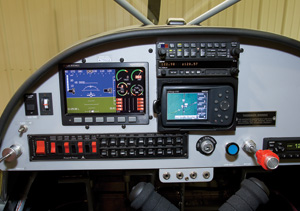
The CH 750’s panel is generously sized; the company demonstrator has a Dynon FlightDEK-D180 combined EFIS and engine monitor.
So much about the CH 750 struck me as being just right for the mission. The enlarged cabin is a real boon. It has good payload—max gross is the LSA legal limit of 1320 pounds against an empty weight typically below 800 pounds (Zenith says 775 is typical), and it holds a useful 24 gallons of fuel, with 28 optional. In addition, the 750 can use a wider range of engines than the 701—for a time, the company had the Continental O-200 up front, and is eager to try the Lycoming O-233 when it’s available. Right now, the most popular engine is the Rotax 912S, with the six-cylinder Jabiru in the mix as well. I was impressed by the smoothness of the Jabiru and the performance. Finally, unlike a lot of kit manufacturers, Zenith accepts that builders will try alternative engines and does what it can to help them.
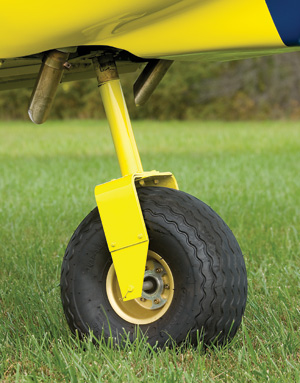
All of the Zeniths have steerable nosewheels with flotation tires.
As I came back into the Mexico pattern for a few more landings in the 750, I found myself enjoying the view of the Missouri countryside and not thinking so much about the airplane. Those little quirks—the Y-shaped stick, low wing loading, unusual sight picture—that pilots unfamiliar with Zenith designs focus on as negatives had largely slipped beneath the surface for me. (Zenith is building a CH 750 at the moment with some other updates, including dual, conventional control sticks that I suspect I would like better still.) The last landing was the best—a short roll, just the right amount of energy at the touchdown point, very comfortable.
I quit while I was ahead and returned the bright-yellow CH 750 to the hangar in the same condition I’d borrowed it, and then congratulated Sebastien Heintz for thoroughly updating and evolving his father’s designs without bringing them too close to the center. Zenith builders are proud of the ways their airplanes are different, and the company is smart enough to not take that away from their crucial point of origin.
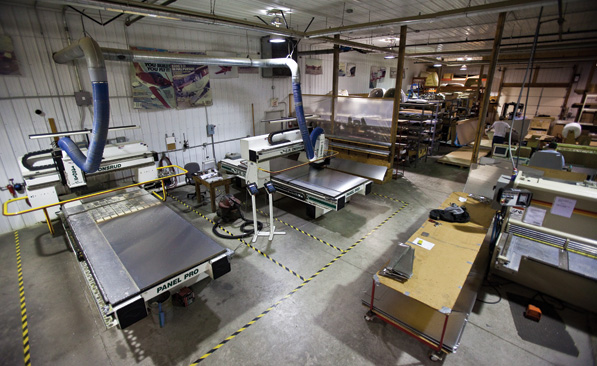
Zenith’s factory includes two CNC routers that eat 6061 aluminum like cheesecake.
For more information, call 573/581-9000 or visit www.zenithair.com.

